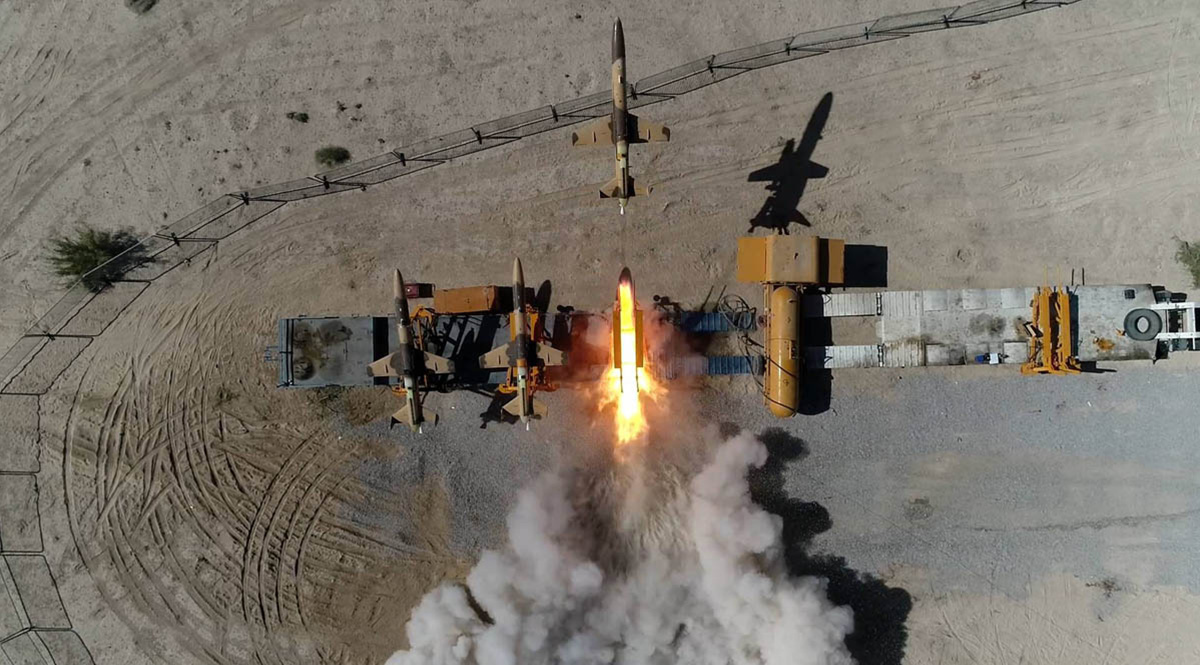Iranian Missile and Drone Strike Rebuffed by Israel, Allies
During the night of 13-14 April, Iran and its regional allies conducted a massive missile and drone attack on Israel. It was in reaction to an earlier Israeli strike on the Iranian embassy and consulate in Damascus, which resulted in the death of high-ranking officers of the Islamic Revolutionary Guard Corps. Iran issued a diplomatic note to the UN after its attack that suggested it is not interested in further escalation. Declarations by the U.S. administration stressed detachment from the expected response by Israel, although further escalation of the regional crisis might be expected.
 Icana News Agency / Zuma Press / Forum
Icana News Agency / Zuma Press / Forum
Why did Iran attack Israel?
Iran’s Mission to the UN in New York in an official statement underlined that the attack was legitimate in the context of international law and in response to the destruction of its consulate and killing of a group of officers by Israel. The government in Tehran not only announced in advance and then confirmed its responsibility for the attack but also organised rallies of support in the Iranian capital and parliament. The attack on Israel was the first one using missiles launched directly from Iran. While avenging the death of high-ranking officers, including Gen. Mohammad Reza Zahdi, the commander of Iranian troops in Syria, Iran likely was also motivated by the intent to demonstrate to Israel its determination and military capabilities to directly strike its rival’s military and civilian centres. Moreover, the Iranian strikes were intended to confirm its key leadership role in the “Axis of Resistance”, which is an alliance with the government of Syria, Shia militias in the region, and Palestinian radicals. Iran also connected its actions as a reaction to the ongoing Israeli ground operation in the Gaza Strip and Western tolerance of the humanitarian catastrophe affecting Palestinians.
Were the attacks effective or the defences?
Iran used in total 331 one-way attack (“kamikaze”) drones and a few types of ballistic and cruise missiles, launched from both Iran and Yemen. The government of Iran presented it as a successful operation, but only a few ballistic missiles hit targets in Israel, which resulted in limited damage to the Nevatim air base, with one killed and 31 lightly wounded Israeli Bedouins. Nevertheless, the scale of the attack on Israel was many times larger than expected by U.S. intelligence. Israel successfully used all elements of its multi-layered missile and air defences, as well as jet fighters, to down the incoming objects. Drones and cruise missiles flying over Syrian and Iraqi airspace were intercepted by U.S., French, and British fighter jets, using the American network of early warning radars in region as well as Jordanian aircraft. It is worth noting that Lebanese Hezbollah also engaged in the attack but limited their involvement to unguided artillery rockets (intercepted partially by Israel’s Iron Dome system), without using more dangerous short-range Fateh ballistic missiles. This suggests, at least at the current stage, the unwillingness of Iran and Hezbollah to escalate the conflict on the Lebanon-Israel border.
Will an Israeli response risk broader regional war?
Israel’s government declared the necessity of a response to the attack by Iran, however the scope and goals of it might be limited in nature. Israel is forced to incorporate the demands for credible deterrence, in particular to Iran as well as to the Axis of Resistance, the ongoing ground operation in Gaza, as well as U.S. and Arab countries’ concerns about further escalation into its response. These factors and the distance of 2,000 km to Iran might limit available strike options to Israeli airpower. Israel’s campaign against the extensive rocket and missile arsenal of Hezbollah might result in regular war in the northern direction, which will be hard to conduct without the deployment of substantial Israeli ground forces. More likely are options that might include intensified elements of the current Israeli strategy against Iranian assets in Syria, and/or cyberattacks or covert operations in Iran. However, Iran is well aware of these options and will be trying to deter Israel from a further exchange of strikes, suggesting readiness to halt any escalation. To this end, Iran declared it could conduct more missile strikes if Israel launches further airstrikes on Iran. Nevertheless, the strength and credibility of the rivals’ deterrence, as well as image, might at some point result in an uncontrolled escalation of the current crisis into a regional war.
What were the initial reactions of the U.S. and international community?
In addition to active assistance in the defence of Israel during the latest attack, the U.S., G7, EU, and NATO countries strongly condemned the missile and drone strike by Iran, and also declared broader sanctions against the Iranian Revolutionary Guard and producers of the drones and missiles. Despite the U.S. full commitment to the strict defence of Israel, the Biden administration publicly and clearly detached itself from any potential military strikes on Iran. According to media reports, an equally strong message was passed through direct consultations with the government of Israel. Both the U.S. and friendly Arab countries are not interested in risking participation in a broader regional war. Ukraine’s rhetoric also strongly supported Israel due to its ongoing experience with Iranian drones used by Russia (deliveries of Fateh missiles from Iran are also expected soon). At the same time, Iran in the UN Security Council is receiving support from Russia and China, which might also limit international community action over the direction of any further escalation of the crisis.








